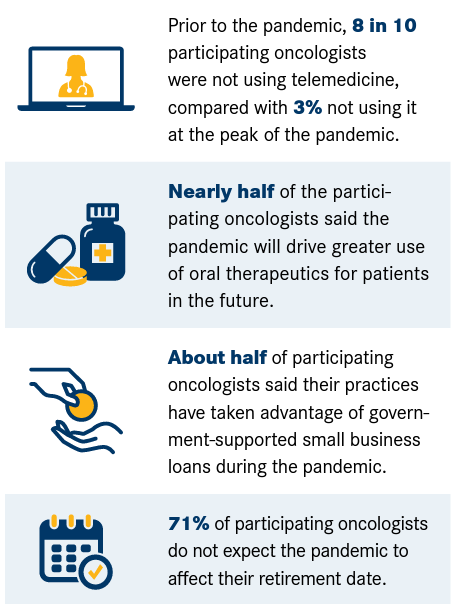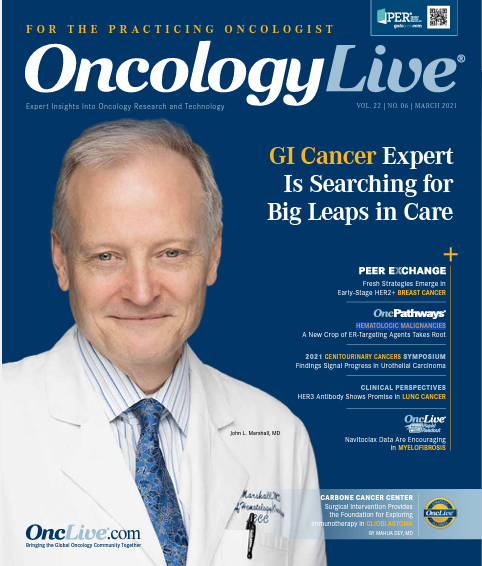Publication
Article
The COVID-19 Pandemic Will Have Long-Term Impact on Oncology Practices
Author(s):
The COVID-19 pandemic created new patient care challenges in oncology, such as how to reduce risks of virus exposure for patients who may be immunocompromised and switching from in-person visits to telemedicine.
Bruce Feinberg, DO

The coronavirus-19 (COVID-19) pandemic has permeated every aspect of health care since March 2020. For oncologists, the pandemic created new patient care challenges, such as how to reduce risks of virus exposure for patients who may be immunocompromised and switching from in-person visits to telemedicine.
As much discussion has been focused on the pandemic’s effect on patients, less is understood about how it has affected health care providers and their practices. For instance, how is the COVID-19 pandemic affecting practices financially? Is it influencing their performance in value-based reimbursement?
Another area that needs to be understood is the pandemic’s effect on the level of stress oncologists face at work. Research conducted by Cardinal Health Specialty Solutions showed that oncologists have responded to the pandemic with resourcefulness and resiliency while managing higher-than-ever stress levels.
More data on the pandemic’s impact were collected by Cardinal Health using a web-based survey sent in September, October, and November 2020. The results reflect the views of more than 190 oncologists from a mix of community- and hospital-based practices across the United States.
Overall, the survey showed that the pandemic has had a far-reaching impact on oncology practices and how oncologists treat patients (Figure 1). For example, about half of participating oncologists said their practices have taken advantage of government-supported small business loans. Additionally, nearly half of participating oncologists said the pandemic will drive greater use of oral therapeutics for patients in the future.
Figure 1. COVID-19’s Impact on Oncologists

In addition, clinicians have been forced to receive information about new therapies in different ways than before (Figure 2). Without the ability to attend medical conferences in person, 63% reported that they have been taking advantage of virtual programming, while 55% said they are relying on medical journals for data about new drugs.
Figure 2. How Oncologists See the Impact of the Pandemic on the Quality of Care

Telemedicine: Here to Stay
Of all the changes to occur because of the COVID-19 pandemic, the adoption of telemedicine might be the most significant shift, having moved from almost nonexistent use before the pandemic to a state where, at the peak of the pandemic, 97% of oncologists were using it to some degree. They are generally satisfied with the experience. Nearly 6 in 10 participating oncologists said their telemedicine experience has been highly positive or better than expected.
However, in more recent months, telemedicine usage has leveled off considerably, oncologists reported. Yet 80% of those surveyed expect to continue using it to some degree post pandemic.
Given the expectation that telemedicine is here to stay, understanding where clinicians believe it to be a safe, effective, and viable solution for ongoing disease surveillance and management is critical.
Participating oncologists said reviewing laboratory/imaging results with patients and routine monitoring of conditions were the 2 areas where telemedicine could best be used.
Survivorship care, management of maintenance therapies, and palliative care were also regarded as potentially suited to telemedicine, albeit to a lesser degree.
Along with monitoring patients, some physicians see telemedicine as a tool that can help prevent unnecessary costs.
For example, William R. Mitchell, MD, chief executive officer and senior partner, Southern Oncology Specialists in Charlotte, North Carolina, said his practice has used telemedicine as a tool for triaging patients who are considering a visit to the emergency department (ED).
“If patients call because they are experiencing an adverse event, the routine response is often to send them to the ED,” he said. “By using telemedicine, we can talk to the patients and see how they look, which helps us to better evaluate their condition and make more informed decisions about whether they need urgent care. Preventing those unnecessary trips to the ER can lead to a significant reduction in costs for patients.”
Although 3 in 5 of surveyed providers reported having a favorable experience with telemedicine, they also addressed remaining barriers such as technology challenges and lack of patient adoption.
In addition, 48% said the use of telemedicine has had a negative financial impact on their practice. Despite these challenges, 60% said their patients have had a favorable experience with telemedicine, which bodes well for future use.
Use of Oral Therapies
The survey also asked oncologists about the transition from infused therapies to oral therapies to limit the number of office visits since the pandemic may continue to affect oncology practices for months. Two-thirds of oncologists have moved at least some patients to oral therapies, according to the survey results.
While these changes have been driven by a need to limit in-person appointments, physicians were split on whether increased use of oral therapeutics would continue after the pandemic is over.
“When evaluating infused therapies versus oral therapies, oncologists need to consider many factors,” Mitchell said. “First and foremost is the well-being of the patient. Infused therapies allow for more direct monitoring of the patient, as well as better adherence to treatment, which can lead to better outcomes. Another factor is the impact on the practice. Shifting a large portion of patients to oral therapies may create operational and financial challenges for many community practices, particularly those that don’t have an in-house pharmacy.”
The challenges of the pandemic have also led to the idea of home care or home infusion services, which about 1 in 3 surveyed oncologists said their practices are offering or considering. This comes with barriers, including staff and resource limitations, patient safety concerns, and payer restrictions.
Financial Impacts Seen As Short Term
The COVID-19 pandemic has also taken a financial toll on practices throughout the country. Ninety percent of surveyed oncologists acknowledged some negative impact. However, nearly 70% said these challenges are only short term, and more than 70% believe they are very confident or confident their practices will return to pre-pandemic levels of success and profitability as COVID-19 wanes.
Nearly half of the participating oncologists have tapped into government-supported loans such as the Coronavirus Aid, Relief, and Economic Security (CARES) Act, in which the Department of Health and Human Services offered financial relief to providers who bill Medicare fee-for-service. In addition, 40% are limiting investments in the practice, and a third are planning to delay any investment by 1 year or more.
Of those participating in value-based care initiatives such as Merit-based Incentive Payment Systems (MIPS) and the Oncology Care Model (OCM), two-thirds say the pandemic has had no negative effect on their performance. However, more than 50% of respondents expect value-based care initiatives will be significantly delayed or shelved as a consequence of the pandemic.
Increasing Burnout
All of these COVID-19-influenced factors can affect oncologists in personal ways, too. Research conducted prior to the pandemic indicated that oncologists were already at higher risk of burnout than providers in other specialties.
Interestingly, the increased feelings of burnout since the pandemic began were not related to a heavier workload. Instead, loss of face-to-face patient interactions was cited as the top factor contributing to physician burnout.
Reduced patient volumes and practice financial loss were also commonly cited. This finding suggests that, while tools like telemedicine may continue to play a role in care, in-person patient care is what drives most oncologists.
“Oncologists get very close to their patients. It is almost like a family relationship,” Mitchell said. “Just as families have been stressed by not being able to spend time together during the pandemic, the inability to connect with patients face-to-face has created added stress for many oncologists.”
Barriers across community-based oncology practices remain an all-too-real challenge as the COVID-19 pandemic continues.
With vaccinations rolling out across the country, though, there is hope that oncology practices will enjoy renewed success sooner rather than later, and the measures adopted in response to the pandemic may yield last-ing improvements to benefit both patients and clinicians.
Bruce Feinberg, DO, is vice president and chief medical officer at Cardinal Health Specialty Solutions.
Reference
- Cardinal Health Specialty Solutions. Views on the impact of the COVID-19 pandemic on oncology practices nationwide. December 2020. Accessed February 19, 2021. https://bit.ly/3aAqyn9










